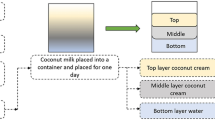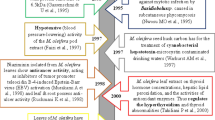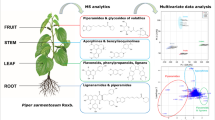Abstract
Three varieties of Damask rose named ‘Four Seasons’, ‘Celsiana’ and ‘Rose de Rescht’, were studied in Beijing in dry and frozen climate. The volatiles emitted from flowers were collected by dynamic headspace collection method and were detected and identified via thermal-desorption cold trap/gas chromatography/mass spectrometer technique (TCT-GC/MS). The results revealed that 63, 68 and 55 species of individual compounds were found from ‘Four Seasons’, ‘Celsiana’ and ‘Rose de Rescht’, respectively. The results demonstrated that ‘Celsiana’ possessed most diverse volatile components; the relative abundance of terpenes was as much as 49%, whereas it was 20 and 40% for ‘Four Seasons’ and ‘Rose de Rescht’, respectively. It meant that the rose oil from flowers of ‘Celsiana’ might be of high quality. Therefore, industrial plantation of ‘Celsiana’ is probably reasonable in Beijing area.
Similar content being viewed by others
References
Achuthan, C.R., B.H. Babu, and J. Padikkala. 2003. Antioxidant and hepatoprotective effects of Rosa damascena. Pharm. Biol. 41: 357–361.
Adams, R.P. 2007. Identification of Essential Oil Components by Gas Chromatography / Mass Spectrometry. 4th ed. Allured Publishing, Illinois, USA.
Alireza, B., R.T.A. Seyed, K.K. Morteza, O. Reza, R.N. Mohammad, D.E. Gerhard, and J.M.S. Marinus. 2007. Microsatellite analysis of Damask rose (Rosa damascena Mill.) accessions from various regions in Iran reveals multiple genotypes. BMC Plant Biol. 7:7–12.
Amjad F., K. Mahnaz, A.K. Muhammad, R. Atif, A.K. Asif, A. Natalie, H.B. David. 2013. Microsatellite analysis of Rosa damascena from Pakistan and Iran. Hort. Environ. Biotechnol. 54:141–147.
Baser, K.H.C. 1992. Turkish rose oil. Perfumer Flavorist 17:45–52.
Basim, E. and H. Basim. 2003. Antibacterial activity of Rosa damascena essential oil. Fitoterapia 74:394–396.
Baydar, H. and N.G. Baydar. 2005. The effects of harvest date, fermentation duration and Tween 20 treatment on essential oil content and composition of industrial oil rose (Rosa damascena Mill.). Ind. Crops Products 21:251–255.
Baydar, N.G., H. Baydar, and D. Thomas. 2004. Analysis of genetic relationships among Rosa damascena plants grown in Turkey by using AFLP and microsatellite markers. J. Biotech. 111:263–267.
Bayzid, Y., T.R. Seyed, D. Farrokh, and A.H. Mohammad. 2009. Flower yield performance and stability of various Rosa damascena Mill. landraces under different ecological conditions. Sci. Hort. 121:333–339.
Farooq, A., A.M. Khan, A. Ali and A. Riaz. 2011. Diversity of morphology and oil content of Rosa damascena ‘Landraces’ and related rose species from Pakistan. Pak. J. Agri Sci. 48:177–183.
Gao Y., Y.-J. Jin, H.-D. Li, and H.-J. Chen. 2005. Volatile organic compounds and their roles in bacteriostasis in five conifer species. J. Integrative Plant Biol. 47:499–507.
Huang C.-Q., B.-L. Guo, W.-H., Huang, J. Sun, L. Li, J.-J. Liu, M. Gao, and C.-Z. Fu. 2011. Analysis of chemical component of essential oil from roseleaf cultivated in Beijing Miaofeng montain by GC-MS. J. Beijing Univ. Agric. 26:46–50.
International Standards for Business, Government and Society (ISO). 2014. ISO 9842:2003, oil of rose (Rosa × damascene Miller). http://www.iso.org/iso/home/store/catalogue_tc/catalogue_detail.htm?csnumber=28611.
Jirovetz, L., G. Buchbauer, A. Stoyanova, A. Balinova, Z. Guangjun and M. Xihan. 2005. Solid phase microextraction/gas chromatographic and olfactory analysis of the scent and fixative properties of the essential oil of Rosa damascena L. from China. Flavour Fragrance J. 20:7–12.
Joulain, D. and W.A. Koenig. 1998. The atlas of spectra data of sesquiterpene hydrocarbons. E.B.-Verlag, Hamburg.
Kaul, V.K., V. Singh, and B. Singh. 2000. Damask rose and marigold: Prospective industrial crops. J. Med. Aromat. Plant Sci. 22:313–318.
Kovacheva, N., K. Rusanov, and I. Atanassov. 2010. Industrial cultivation of oil bearing rose and rose oil production in Bulgaria during 21st century, directions and challenges. Biotechnol. Biotechnol. Equipment 24:1793–1798.
Kumar R., S. Sharma, S. Sood, V.K. Agnihotri, V. Singh, and B. Singh. 2014. Evaluation of several Rosa damascena varieties and Rosa bourboniana accession for essential oil content and composition in western Himalayas. J. Essential Oil Res. 2014, 26:147–152.
Mahmood N., S. Piacente, C. Pizza, A. Burke, A. Khan, and A. Hay. 1996. The anti-HIV activity and mechanisms of action of pure compounds isolated from Rosa damascena. Biochem Biophys Res. Commun. 229: 73–79.
Mollov, P., K. Mihalev, V. Shikov, N. Yoncheva, and V. Karagyozov. 2007. Colour stability improvement of strawberry beverage by fortification with polyphenolic copigments naturally occurring in rose petals. Innovative Food Sci. Emerging Technol. 8:318–321.
Ozkan, G., O. Sagdic, N.G. Baydar, and H. Baydar. 2004. Antioxidant and antibacterial activities of Rosa damascena flower extracts. Food Sci. Technol. Int. 10:277–281.
Probir, K.P. 2013. Evaluation, genetic diversity, recent development of distillation method, challenges and opportunities of Rosa damascena: A review. J. Essential Oil Bearing Plants 16:1–10.
Renata, N., O. Marta, P. Łukasz, O. Wiesław, L. Renata, M. Anna, and R. Jolanta. 2013. Cytotoxic, antioxidant, antimicrobial properties and chemical composition of rose petals. J. Sci. Food Agric. 94:560–567.
Rusanov, K., N. Kovacheva, B. Vosman, L. Zhang, S. Rajapakse, and I. Atanassov. 2005. Microsatellite analysis of Rosa damascena Mill. accessions reveals genetic similarity between genotypes used for rose oil production and old Damask rose varieties. Theor. Appl. Genet. 111:804–809.
Rusanov, K., N. Kovacheva, and I. Atanassov. 2011. Comparative GC/MS analysis of rose flower and distilled oil volatiles of the oil bearing rose Rosa damascene. Biotechnol. Biotechnol. Eq. 25:2210–2216.
Rusanov, K., N. Kovacheva, K. Stefanova, A. Atanassov, and I. Atanassov. 2009. Rosa damascena-genetic resources and capacity building for molecular breeding. Biotechnol. Biotechnol. Eq. 23:1436–1439.
Rusanov, K., N. Kovacheva, M. Rusanova, and I. Atanassov. 2011. Traditional Rosa damascena flower harvesting practices evaluated through GC/MS metabolite profiling of flower volatiles. Food Chem. 129:1851–1859.
Rusanov, K., N. Kovacheva, M. Rusanova, and I. Atanassov. 2012. Low variability of flower volatiles of Rosa damascena Mill. plants from rose plantations along the rose valley. Bulgaria Ind. Crops Products 37:6–10.
Shikov, V., D.R. Kammerer, K. Mihalev, P. Mollov, and R. Carle. 2012. Antioxidant capacity and colour stability of texture-improved canned strawberries as affected by the addition of rose (Rosa damascena Mill.) petal extracts. Food Res. Inter. 46:552–556.
Ulusoy, S., G. Boşgelwez-Tinaz, and H. Seçilmiş-Canbay. 2009. Tocopherol, carotene, phenolic contents and antibacterial properties of rose essential oil, hydrosol and absolute. Curr. Microbiol. 59:554–558.
Verma, R.S., R.C. Padalia, A. Chauhan, A. Singh, and A.K. Yadav. 2011. Volatile constituents of essential oil and rose water of damask rose (Rosa damascena Mill.) cultivars from North Indian hills. Natural Product Res. 25:1577–1584.
Younis, A. 2006. Phyto-chemical analysis and potential for exploitation of heterosis of essential oil of Rosa. Ph.D. Diss., University of Agriculture Faisalabad, Pakistan.
Younis, A., M.A. Riaz, and A.A. Khan. 2009. Effect of time of growing season and time of day for flower harvest on flower yield and essential oil quality and quantity of four Rosa cultivars. Floriculture Ornamental Biotechnol. 3:98–103.
Younis A., M.A. Khan, A.A. Khan, A. Riaz and M.A. Pervez. 2007. Effect of different extraction methods on yield and quality of essential oil from four Rosa species. Floriculture Ornamental Biotechnol. 1:73–76.
Yu, Z., Y.-F. Yi, Y. Wu, X.-J. Yu, P. Wang, and J.-K. Ding. 1994. The comparison of the chemical constituents and the odor of four rose oil. Acta Bot. Yunnanica 16:75–80.
Author information
Authors and Affiliations
Corresponding author
Rights and permissions
About this article
Cite this article
Yang, L., Ren, J. & Wang, Y. Chemical investigation of volatiles emitted from flowers of three varieties of Damask rose cultivated in Beijing. Hortic. Environ. Biotechnol. 55, 524–530 (2014). https://doi.org/10.1007/s13580-014-0176-5
Received:
Revised:
Accepted:
Published:
Issue Date:
DOI: https://doi.org/10.1007/s13580-014-0176-5




